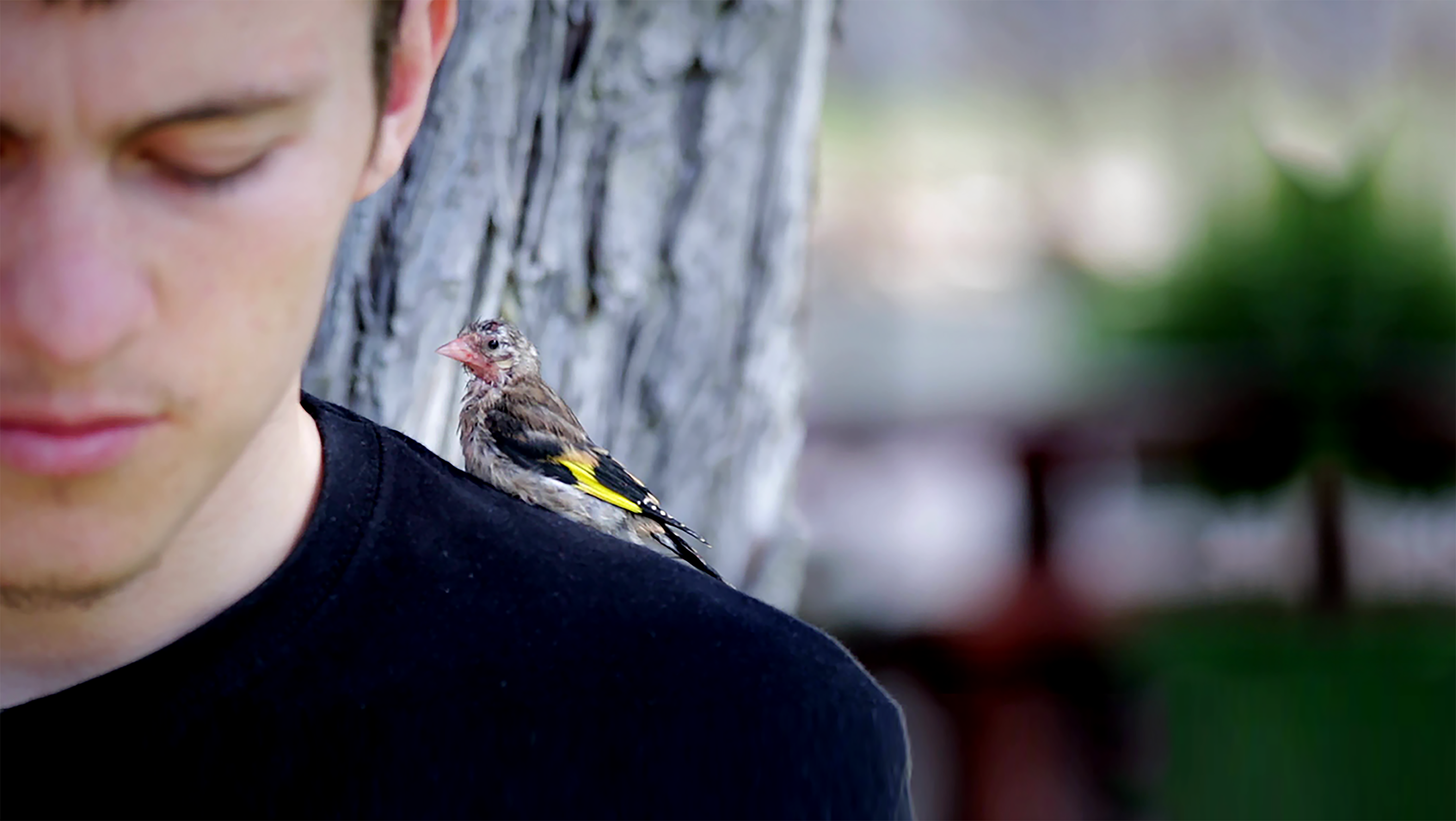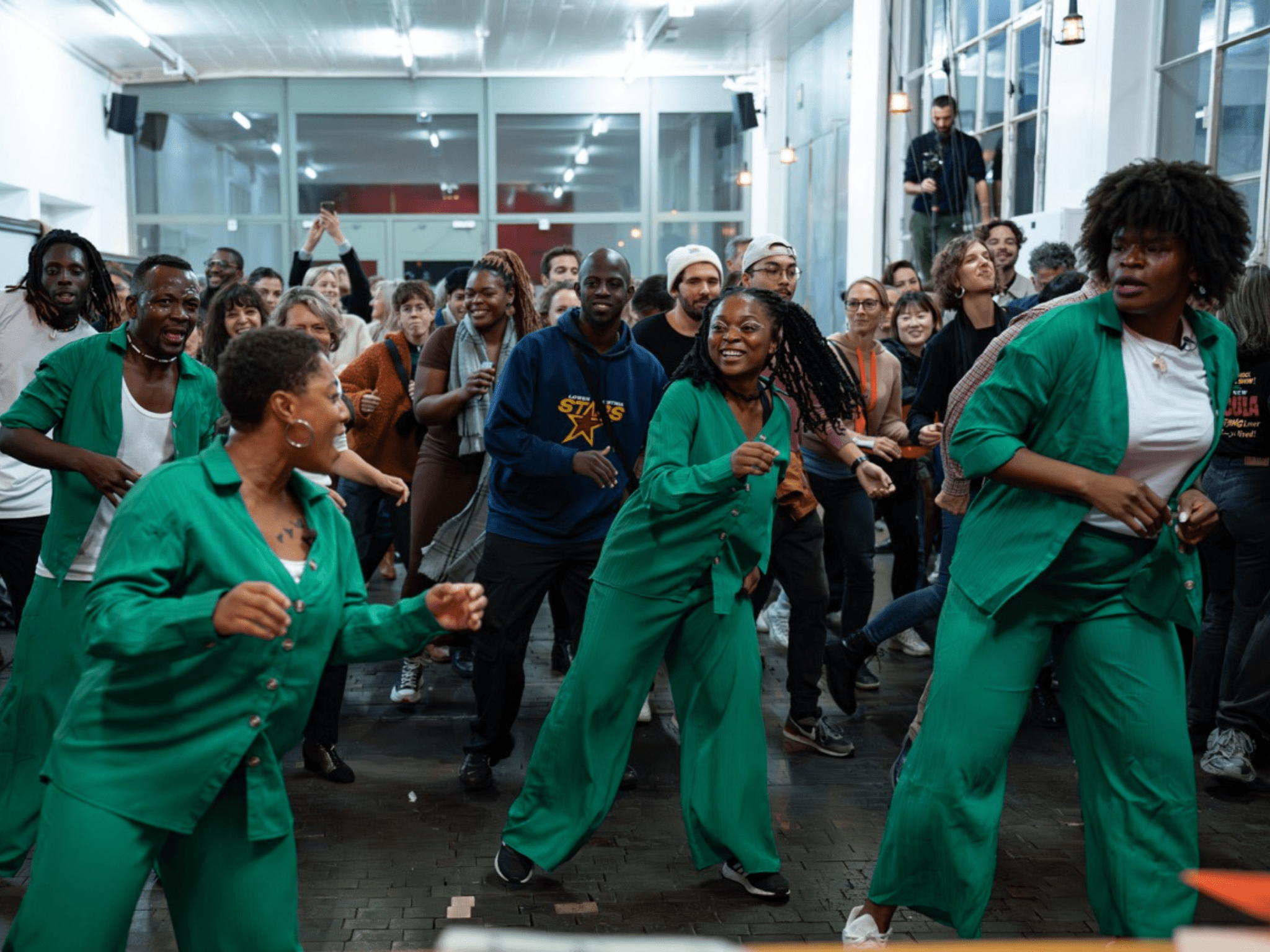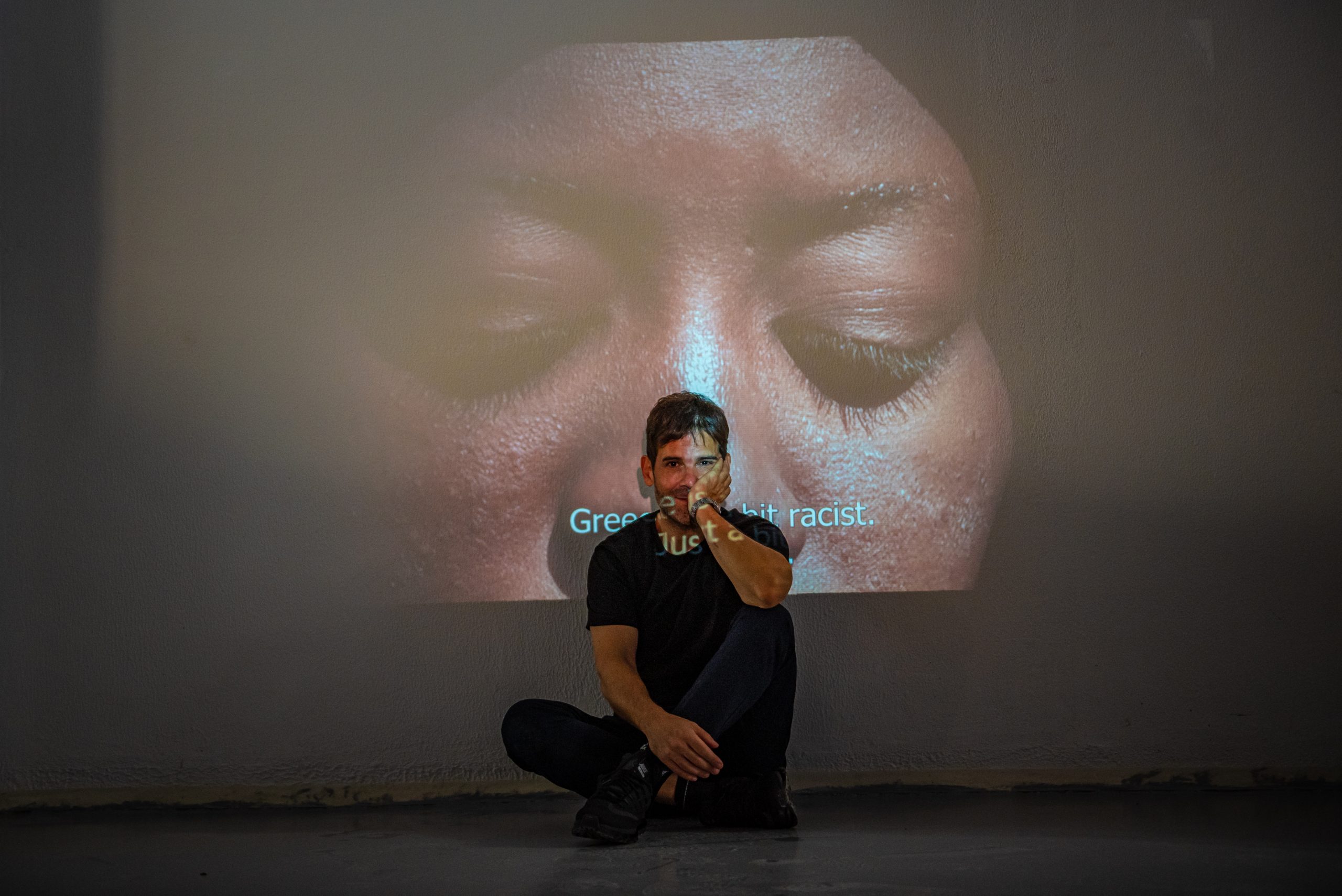
Features #26 - December 2023
Menelaos Karamaghiolis
NICOLAS VAMVOUKLIS IN CONVERSATION WITH MENELAOS KARAMAGHIOLIS
Your exhibition “Re/member Your House” at the Centre d’Art Contemporain Genève marks your first major European retrospective, featuring an eclectic selection of video works and installations. What is the common thread that brings these specific pieces together, and what does it mean for you to showcase them there?
The common thread that weaves through all the exhibition floors lies in its title, which references the title of a 30-page manuscript by James Baldwin that he left unfinished when he returned to America from Paris in the 1960s. At a time when racial discrimination was resulting in murders alongside the struggles for sexual and artistic liberation, Baldwin returned to the place where he was born but was always dismissed as black, an artist, and gay.
What might initially appear as fragmented within Baldwin’s text resonates profoundly today, establishing an enduring link among the heroes depicted in the exhibition’s works. These individuals share a common struggle—redefining their identity while confronting relentless obstacles. These heroes navigate challenges with resilience, whether hindered by their skin color, imprisoned status, restricted mobility, homelessness, or even posthumously asserting life through artistic endeavors.
Within the exhibition space, the significance of the setting parallels that of the artworks and their protagonists. Andrea Bellini’s meticulous curation unfolds in Switzerland, a liminal space in Europe. This context acts as an imperceptible artistic bridge, connecting heroes contending with assimilation into new homelands. They exist in a perpetual in-betweenness, negotiating borders while steadfastly preserving their right to memory, embracing their origins, and safeguarding their freedom of movement and expression.
Your work is known for stories of invisible everyday heroes, often linked to Greece’s social and political crises. How do you believe these narratives speak to European society at large?
I was captivated by the exhibition’s design by Andrea Bellini, which skillfully narrates Greek reality, diverging from the conventional portrayal found in tourist guides. It serves as a prophetic and representative microcosm, offering insights into the new conditions asserting dominance worldwide. As visitors traverse the multimedia installations across various floors, they immerse themselves experientially in stories and landscapes often overlooked or intentionally bypassed—encountering the stereotypes, fallacies, and misunderstandings that typically cloak and distort this reality.
Strategic decisions, including the placement of artworks, meticulous lighting, and purposefully concealed details, collectively construct a liminal universe. This curated space not only renews contemporary art’s connection to reality and history but also grants viewers the freedom to navigate and draw conclusions. Bellini’s thoughtful decision to provide a platform for these works and the often overlooked “invisible” heroes (anti-heroes) is commendable. It unveils a crucial, unpredictable, critical, and dynamic Greece, creating a dialogue with the concept of borders and boundaries, which returns to Geneva, where Kapodistrias, the first ruler of modern Greece, envisioned it.
Even the exhibition poster aligns with this narrative: the Greek flag, portrayed in different colors with a conspicuous strip missing, symbolizes a deeper narrative. What unfolds within the realm of these exhibition heroes isn’t an isolated tale confined to the edges of Europe; instead, it sheds light on critical dilemmas resonating across the entire continent.
Many of your films unfold against the backdrop of Athens, and one that struck me was “MY POINT OF VIEW VS YOUR LENS,” which presents the unique vantage point of a stray dog named Benji capturing the 2011 protests at Syntagma Square. It offered a fresh and unexpected perspective on the urban landscape. I’m curious about the enduring fascination that keeps you returning to the public space…
The exhibition’s third floor unfolds with a poignant narrative, beginning with a bird that matures over five years within the confines of a prison cell. It concludes with the tale of a stray dog actively participating in protests at the city’s main square, fearlessly inserting itself – through barks – into the clashes between armed police officers and demonstrators. The dog’s unconventional stroll amidst the chaos defies cinematic norms, transforming people into quasi-painted figures reminiscent of Bacon and Kessanlis: the dog itself. Its movement triggers unexpected dialogues with photography, painting, and the moving image that, a century ago, feverishly redefined representationalism and realism in the arts.
Within the same square, a public space adopted as its home, the stray dog becomes a filmmaker, capturing hours of footage for the exhibition’s final work. The dog challenges conventional perspectives by critically assessing filmmakers, our indiscriminate lenses, and the fallacy of capturing everything to pursue potential immortality. In the vibrant cityscape of Athens, where I am disheartened by those confined within homes shielded by perpetually lowered awnings, the stray dog imparts life lessons in freedom and audacity. It redefines the concept of home, breaking through traditional barriers like walls and boundaries, establishing an outdoor “house” in the bustling central hub of a major city right before its parliament amidst protesters and the explosive turmoil of police bombs.
The Centre’s “Cinema Dynamo” currently screens selected fiction and documentary films, as well as a series of your short films. Rewatching “ROM” (1989), hailed as a pivotal moment in Greek documentary filmmaking, was an emotional experience for me, mainly due to the evocative soundtrack by Nikos Kypourgos that skillfully delves into Romani life. How do you feel when revisiting earlier works like this one?
The truth is that the film “ROM” has never let me forget it or take my distance from it because it has already lived three different lives. Its latest chapter began when La Cinémathèque française hailed it as an avant-garde cinema masterpiece. Since then, it’s been screened globally, sparking engaging discussions. In these talks, I listen more than speak, posing provocative questions that draw dynamic answers. Films, when completed, fortunately, gain autonomy from their creators, forming a direct bond with the audience. I felt this with the fiction film “J.A.C.E. – Just Another Confused Elephant,” showcased on the top floor of the Centre d’Art Contemporain Genève. Curator Andrea Bellini’s decision to end the exhibition in a cinema hall with a selection of my films from 1986 to today created an essential dialogue between cinema and contemporary art. There, a notable space of freedom emerged, where “ROM” was screened for the first time without the censorship imposed by Greek Public Television in 1989. Bellini has established a great tradition at the Centre, exploring innovative displays for works based on the moving image. Our dialogue has opened new perspectives on my work’s future.
In a touching homage to your late friend Stelios Faitakis, a remarkable Greek painter who recently left us, your exhibition includes a special room displaying four of his paintings. I’m interested to learn about the bond you shared and what significance friendship holds in your life.
I met Stelios Faitakis after a 2007 interview where he named me one of the two Greek artists he believed in. I told him he was mistaken, starting a conversation on art, the secrets of Byzantine painters, and our shared belief that all art is political. We agreed that artists must be activists in constant interaction with their surroundings. Our dialogue continued through various mediums: radio, lengthy written messages, exhibitions, and films. Our discussions inspired me to explore how the moving image could extend beyond cinema into art spaces and the public realm. Faitakis often pushed me to explore “sinful” thematic mixes and intersections, such as in a video on faith, hagiography, and the commercialization of the Virgin Mary. “Isn’t that what I do?” he reassured me when I had doubts. The belief (or hope) that artists live on after death, as long as their works are exhibited, motivated me to continue our dialogue in this Geneva exhibition. Setting up his works was challenging; looking at them, I realized for the first time that Stelios would never paint again. It brings me joy when visitors stand in front of his works, observing, photographing, and offering interpretations of inscriptions and faces.
Alongside your retrospective, the Centre presents “the AfroGreeks,” an ongoing community work by the Døcumatism collective. Could you introduce me to this project and your collaboration with its curator, Grace Chimela Eze Nwoke?
This is a project I’ve been devoted to for years as a member of Døcumatism, aimed at dispelling the label of “ghetto” from my neighborhood, Kypseli. It provides a platform for the vibrant and diverse community of Greeks of different backgrounds. Through collective processes, I express myself and explore alternative ways of coexistence, whether involving people of varied origins or integrating moving images with public actions.
In 2015, the film faced financial challenges, leading to a unique model where the moving image, from production to distribution, catalyzes public actions, dialogues, and encounters. This model gives a platform to heroes and artists, with video protagonists actively participating in the film production, forming a collective where mutual support, learning, disagreement, redefinition, and expression take center stage. Key to this group and project is the performer and anthropologist Grace Nwoke, who, as curator in Geneva, presents an introduction to the work through research materials, videos, and live actions during the exhibition.
“the AfroGreeks” is an ongoing collective community project to be presented as a video installation complemented by live events, workshops, open discussions, film screenings, community collaborations, and other actions. It aims to amplify the voices of the “invisibles” of Athens, who claim their identity as Greeks of African origin.
Døcumatism’s project “the AfroGreeks” began in 2015, initiating public discussions in Kypseli in 2019 about the African community in Athens. It included installations in the library for immigrants, “We Need Books,” and the Catholic Church, accompanied by parallel events organized by the African community. The term gained visibility, mainly through Instagram, and was adopted by young people of African descent who were curious about the project’s purpose.
The project features so far 200 AfroGreeks as protagonists, living and working in Greece, proudly asserting their origin, claiming their right to be artists, and striving for self-expression. Their creative involvement in the collective project provides a platform to counter racism through art, allowing them to become visible and declare their artistic identity. The overarching goal is to create an archive, the first record of the history of the African community in Greece in the 20th and 21st centuries, integrated into the national narrative and Greek history.
The project is significant for its heroes and contributing artists, as the Afro-Greeks are “recognized” as Greeks through artistic procedures. As artists, they engage in workshops connecting them with their history and past. A “task force” operates as part of the project, intervening in crucial questions and addressing daily challenges the heroes face, including bureaucratic and procedural issues.
Menelaos, I would like to conclude with a question posed at your solo show “Dance your way around us” at RODEO in Piraeus earlier this year. I must admit that I visited the gallery multiple times, positioning myself between the two artworks narrating women’s tales on rituals, power, and faith. Throughout this contemplation, I kept asking myself: “Where does the miraculous take place?”
Sylvia Kouvali provided the answer in her text for the exhibition, asserting it practically through the unpredictable setup of the exhibition itself, like a miracle. I still ponder how this exhibition, with its unique works, came into being and how the monumental RODEO was transformed into a cinema hall of the future. The gallery seamlessly integrated cinema into a coherent and interactive public environment where viewers could dance, and painting took on sculptural dimensions, coexisting dynamically with the moving image.
I’m referring to the outstanding works by Apostolos Georgiou in the adjacent exhibition of RODEO, which engaged with “Dance your way around us.” The miracle perhaps lies in this openness: when art exposes its fears, it fosters intense coexistence and magical encounters with those who sincerely love and believe, even if they won’t admit it. There, I sensed a miracle waiting for us, for all of us, even when it might seem contrived or staged.
I will continue to believe that a miracle will happen. I’ve identified it hidden in enduring faith and perseverance. It’s what led all the women in this exhibition to reject the commercialization of their faith daily and to claim their own miracles.
PHOTO CREDITS
View of the opening of Re/member Your House at Centre d’Art Contemporain Genève and of the performance Afrodance with the Roots, 2023
© Centre d’Art Contemporain Genève. Photo: Univers Plaza
Menelaos Karamaghiolis A Bird in Search of a Cage (still) 2012-2019 Video installation 11:28 min
Courtesy of the artist and RODEO
View of the opening of Re/member Your House at Centre d’Art Contemporain Genève and of the performance Afrodance with the Roots, 2023
© Centre d’Art Contemporain Genève. Photo: Univers Plaza
Exhibition view of Re/member Your House with the project the AfroGreeks by Døcumatism and a solo show by Menelaos Karamaghiolis at Centre d’Art Contemporain Genève, 2023
© Centre d’Art Contemporain Genève. Photo: Julien Gremaud
Menelaos Karamaghiolis
DANCE YOUR WAY AROUND US, 2023
Installation view at RODEO, Piraeus, 2023
Courtesy of the artist and RODEO


































